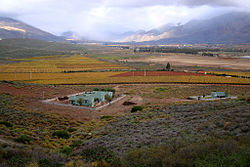| This article needs additional citations for verification. Please help improve this article by adding citations to reliable sources. Unsourced material may be challenged and removed. Find sources: "De Doorns" – news · newspapers · books · scholar · JSTOR (July 2011) (Learn how and when to remove this message) |
| De Doorns | |
|---|---|
 A view of the Hex River Valley A view of the Hex River Valley | |
  | |
| Coordinates: 33°29′S 19°41′E / 33.483°S 19.683°E / -33.483; 19.683 | |
| Country | South Africa |
| Province | Western Cape |
| District | Cape Winelands |
| Municipality | Breede Valley |
| Government | |
| • Councillor | Daniel Teswin Willemse |
| Area | |
| • Total | 7.6 km (2.9 sq mi) |
| Population | |
| • Total | 11,278 |
| • Density | 1,500/km (3,800/sq mi) |
| Racial makeup (2011) | |
| • Black African | 40.0% |
| • Coloured | 51.5% |
| • Indian/Asian | 0.6% |
| • White | 6.0% |
| • Other | 1.9% |
| First languages (2011) | |
| • Afrikaans | 64.0% |
| • Xhosa | 25.2% |
| • Sotho | 3.7% |
| • English | 2.5% |
| • Other | 4.5% |
| Time zone | UTC+2 (SAST) |
| Postal code (street) | 6875 |
| PO box | 6875 |
| Area code | 023 |
De Doorns is situated in the Breede Valley Local Municipality, Cape Winelands District Municipality in the Western Cape province of South Africa.
Location
It lies in the Hex River Valley on the N1 national route, 32 km north-east of Worcester and 40 km south-west of Touwsrivier. It is in the centre of an export grape growing region, surrounded by over 200 table grape farms.
History
The town takes its name from the farm "De Doorns boven aan de Hex Rivier" (‘the thorns on the upper Hex River’), known as early as 1725. The area was declared a sub-drosty of Tulbagh in 1819 and the farm became the seat of the area's own drostdy in 1822.
The De Doorns farm was bought by the government of Cape Prime Minister John Molteno in 1875, to build a railway station for the rapidly expanding Cape Government Railways. The line was immediately built through De Doorns, connecting it to Cape Town on the coast and reaching Montagu Road (later Touws River) in 1877, on its way to Kimberley. Around the station, the hamlet of De Doorns would later develop.
The area around the town became an important region for table grape farming. It had the necessary infrastructure for exporting its produce, and the longest harvest season in the world - December to April. During the second Anglo-Boer War (1899-1902), the town and its railway infrastructure played an important supporting role. The stone blockhouses which were built to protect the vital railway link are still found in the valley.
A village management board was instituted for De Doorns in 1933 and municipal status attained in 1951.
References
- ^ Sum of the Main Places De Doorns, Hassie Square and Ekupumeleni from Census 2011.
- C. Schoeman: The Historical Karoo: Traces of the Past in South Africa's Arid Interior. Penguin Random House South Africa. ISBN 1770225684
- Burman, Jose (1984), Early Railways at the Cape. Cape Town: Human & Rousseau. ISBN 0-7981-1760-5
- Schmidt J.: Call of the Muezzin - Cape to Riyadh. Partridge Africa, Johannesburg. 2014. ISBN 1482803976
- "Dictionary of Southern African Place Names (Public Domain)". Human Science Research Council. p. 132.
| Municipalities and communities of Cape Winelands District Municipality, Western Cape | ||
|---|---|---|
| District seat: Stellenbosch | ||
| Witzenberg |  | |
| Drakenstein | ||
| Stellenbosch | ||
| Breede Valley | ||
| Langeberg | ||